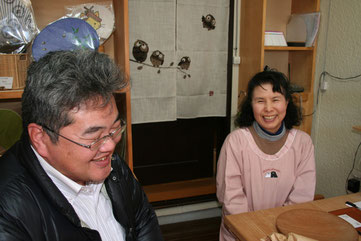Collaboration with Boshu-Uchiwa, designated Traditional Crafts, from Chiba prefecture

Boshu Uchiwa

Boshu-Uchiwa, from Chiba prefecture, is one of the three major uchiwa fans in Japan (Kyo-Uchiwa, Marugame-Uchiwa, and Boshu-Uchiwa).
Uchiwa-making in Kanto area began in the Edo period. At that time, Boshu, the southern part of the Boso peninsula, was a production area of bamboo which was supplied to the Edo-city as material of uchiwa.
In the Meiji period, around 1877, uchiwa-making in Boshu started.
The Great Kanto Earthquake, which occurred in 1923, burnt most of uchiwa wholesalers located in Horie-cho, Nihonbashi, Tokyo.
After the earthquake, some of the wholesalers moved to Funakata-cho (today's Funakata, Tateyama city, Chiba prefecture), since it was close to the bamboo producing area and to the port of Nago, which had a direct ship to Tokyo-city. In this way, uchiwa- making had been spread into the surrounding areas.
As a sideline for fishermen's wives

This area, such as Nago, Funakata or Tomiura has traditionally been a fishermen’s village. Uchiwa-making became an ideal sideline at home among the fishermen’s wives, who took care of the households when their husbands were away. The skills were handed down from mothers to daughters. From the end of Taisho period to the beginning of Showa period (about 1920s-1930s), 7 to 8 million uchiwas were produced each year, while almost 1,000 people took part.
But now, electric fans and air conditioners became widespread. People stopped using uchiwas for practical purposes. Presently, about 300,000 Boshu-uchiwas are produced every year.
In such situation, Boshu-uchiwa was designated as Traditional Crafts by the Ministry of Economy Trade and Industry in 2002. This is the solely designated one as such in Chiba prefecture.
Today, only 5 makers continue production, and they are struggling with the difficulties of craftsmen aging and lack of successors.
The distance to collaboration

Even though the Sekishu-banshi was recognized as the Intangible Cultural Heritage by UNESCO, we had been always thinking that we had to propose a new way to use Sekishu-banshi, since our
lifestyle had significantly changed.
In 2013, Shimane prefecture joined the commemorative events of the 1300th Anniversary of ‘Kojiki’. There was a suggestion to make an uchiwa of ‘Shimanekko’, the authorized character of Shimane
prefecture, so that we made a sample uchiwa with Sekishu-washi made of kozo.
However, the sample uchiwa with a plastic framework was completely unpopular.
‘Plastic frame doesn’t go well with the quality of washi paper.’
‘I don’t want it.’
‘This hardly sells’
But there is neither the technique to make an uchiwa framework nor technique to put a paper on it in Shimane.
We started to look for a way to collaborate with another production area of a traditional craft.
There are 3 areas of traditional uchiwa-making.
Kyo-uchiwa from Kyoto, Marugame-uchiwa from Kagawa prefecture, and Boshu-uchiwa from Chiba prefecture. Concerning Boshu-uchiwa, there is no area of producing Japanese paper around them, and we have met each other at the meetings of craftsmen of Traditional Crafts which are held a couple of times a year. That is why we have decided to collaborate with Boshu- uchiwa craftsmen.
There are 5 makers of Boshu-uchiwa, and 4 of them agreed to cooperation.
Fortunately, we were able to receive a local subsidy. We could complete the Boshu uchiwa both with Sekishu-banshi (the Japan Important Intangible Property, the UNESCO Intangible Cultural
Heritage) and Sekishu-washi (Designated Traditional Crafts).
Popular Shimanekko Uchiwa

In this way, Uchiwa with an ideal quality and texture completed.
Besides, as for a souvenir of Shimane, we could sell uchiwas, on which Shimanekko was printed, at Izumo Taisha Shrine and in Matsue-city.
Shimanekko, the popular mascot of Shimane, also supports us.
Though it is needless to say that securing raw materials, time consuming process, and elevation of the techniques are very important, we continue challenges to the inexperienced things, because
we think that effort to create popular products is also essential to succeed the traditional techniques to the future generation.
We are always groping for the better way to make Sekishu-washi widely known and used.




